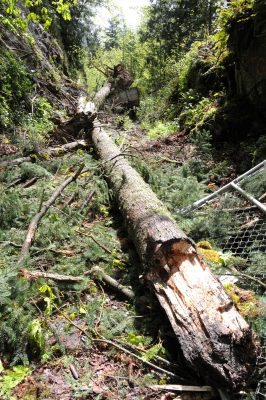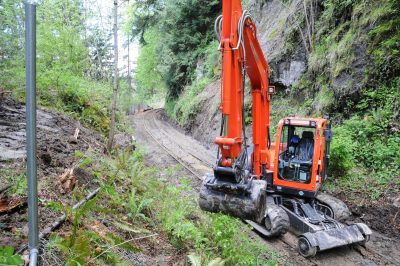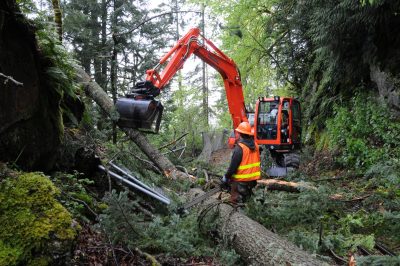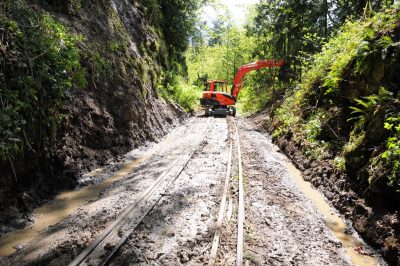 The Northwest Railway Museum has a train load of experience managing natural disaster recovery operations. The Museum has successfully recovered from major floods, moderate earthquakes, hurricane-force wind storms, and even landslides.
The Northwest Railway Museum has a train load of experience managing natural disaster recovery operations. The Museum has successfully recovered from major floods, moderate earthquakes, hurricane-force wind storms, and even landslides.
The Museum applied its experience again this week with a minor landslide at Snoqualmie Falls. Late on Monday, 3 May 2010, about 150 cubic yards of mud and rock and a dozen trees came down the hillside near bridge 31.3. The largest of the trees landed on a gondola car the Museum uses as an end of track bumper. This presented a few minor challenges for School Train scheduled for Tuesday, Wednesday and Thursday, and a concern for the success of Mother’s Day weekend trains.
The track on both sides of bridge 31.3 sits on a ledge cut into the hillside by 19th Century railroad builders 300 feet above the Snoqualmie River. Slides are inevitable and safely collecting and disposing of debris can be difficult. For this type of challenge where safety and critical timelines are factors, the Museum sometimes turns to contractors.


 Also participating was Clayton Littlejohn from North Fork Enterprises. Littlejohn is an expert logger from a family of loggers and the most experienced person in our community for untangling a timber mess. He made quick order of the trees, some more than three feet in diameter. Loggers are an increasingly rare breed in the Northwest as business focus continues to shift away from forestry. The Museum has a close tie to logging – railroads not only made logging viable, but profitable. The railroad allowed Snoqualmie to develop as a successful Weyerhaeuser community and when the mill closed, the railroad left.
Also participating was Clayton Littlejohn from North Fork Enterprises. Littlejohn is an expert logger from a family of loggers and the most experienced person in our community for untangling a timber mess. He made quick order of the trees, some more than three feet in diameter. Loggers are an increasingly rare breed in the Northwest as business focus continues to shift away from forestry. The Museum has a close tie to logging – railroads not only made logging viable, but profitable. The railroad allowed Snoqualmie to develop as a successful Weyerhaeuser community and when the mill closed, the railroad left.
 In the tight confines of the ledge that the railroad sits on, much of the slide debris had to be removed from the site. Thom Weber of Mt. Si Quarry agreed to accept mud and disposed of 30 tons of material. Clayton Littlejohn of North Fork Enterprises accepted all the woody debris and ground it up for use as hog fuel.
In the tight confines of the ledge that the railroad sits on, much of the slide debris had to be removed from the site. Thom Weber of Mt. Si Quarry agreed to accept mud and disposed of 30 tons of material. Clayton Littlejohn of North Fork Enterprises accepted all the woody debris and ground it up for use as hog fuel.
This section of rail line was originally constructed in 1889 and after this minor repair is again ready for service. It will continue to captivate visitors with panoramic views of the valley below and help educate about the challenges 19th Century railroad builders faced when they reached the mountains.


Are their any future plans to extend the tracks further into the woods?